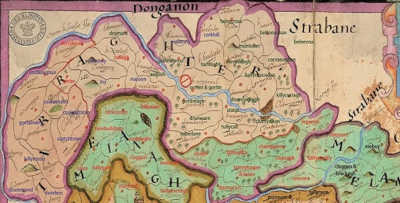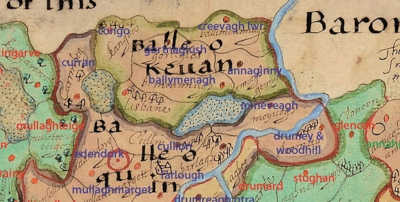The Townland Atlas of Ulster
Researchers and genealogists looking into their Irish family history have long felt need for a comprehensive townland atlas to give context to their findings and assist their research.

The Townland Atlas of Ulster, a new publication from Ulster Historical Foundation, will provide an invaluable guide to the newcomer to the townland system as well as opening up the world of seventeenth-century records to the serious researcher.
In preparing just such a publication, and to greatly increase its value and utility to the researcher, it was decided to base the atlas on 17th-century grants and landed estates for a number of reasons:
- The landholding pattern established in the 17th century largely survived into the 20th century when the full effect of the Land Purchase Acts changed things radically;
- To draw attention to the large body of material still surviving from that period;
- To demonstrate the continuity of the townland as a fundamental unit of Irish life, which was ancient when Bodley produced his maps before the Plantation of Ulster.
- The origins (and subsequent acquisitions) of the seventeenth-century landlords gives us valuable insight on the migrations (both external and internal to Ulster) of their tenants.
The compilation of the maps and (more importantly) the index has involved a close study of the following sources:
- Bodley maps, 1609
- Plantation grants, c. 1610
- Inquisitions
- Post plantation surveys, 1611–22
- The muster rolls, c. 1630
- Civil survey, 1650s
- Down Survey, 1650s
- Books of Survey and Distribution, 1660s–80s
- ‘1659 census’
- Hearth Money Rolls, 1660s
- Estate papers.
None of these sources gives a complete view of the nine counties forming the province of Ulster and one of the aims is to provide a reference work with a consistent naming system to allow easier access to the rich seventeenth-century materials for those who have not had the privilege of studying them in detail.
Brightly coloured maps have been produced for each of the 78 baronies (with every townland named) showing the civil, Anglican and Roman Catholic parish boundaries and the all-important estates. The narrative explains the relevance of each different land division and what records were kept at each level. The evolution of parish boundaries from the 17th century are briefly traced and there are notes on each estate to enable them to be found in primary records.
The Atlas provides an invaluable guide to the newcomer to the townland system as well as opening up the world of seventeenth-century records to the serious researcher. Although it represents a snapshot in time, it is a dynamic snapshot – of relevance to the last 400 years of our history and society.
The early 17th Century was a time of great turbulence in our society, but also of continuity. Most importantly to us, it was a time of diligent record keeping which we can access today to understand better where we have come from. From the licence to distil whiskey in 1608 to the statistics which even then oiled the wheels of government, we can recognise our modern world in the records of 400 years ago.
Fundamental to ‘place’ is (or was) the townland – confusing to outsiders (and now many of us locals) this unit of land has been in use for centuries, from the 12th-century land grants of mediaeval monasteries to the line on your domestic rates bill today. Until the mid-20th century (and much later in some localities), rural addresses were given exclusively by townland and the road names and numbers we use today were meaningless to country dwellers. Small enough to be personal in scale but significant enough for government use, townlands stood the test of time until the processing power of computers and our increasingly mobile and urbanised society brought in postcodes and an increasing number of administrative divisions adrift from our history.
This publication maps all 16,000 townlands in the 9 counties of Ulster and the administrative units of church and state into which they have been organised. In an attractive and easily understood layout, these units are shown in the context of land ownership in the 17th century, a pattern clearly recognisable until a century ago when the Land Purchase Acts broke up the estates and facilitated tenant farmers buying their own land. By using the maps and index, family and local historians can easily grasp the essentials of our ancestors’ lives – where they worked, paid their rent, went to church and market, etc.
This is an essential reference guide for both newcomer and serious researcher, showing exact locations and where to look for related records. This material has never been collated for the entire province before.
ABOUT THE AUTHOR
Andrew Kane works as a Research Consultant for the Ulster Historical Foundation handling a wide range of, mainly genealogical, commissions and assisting in delivering their course programmes. He is a Trustee of the North of Ireland Family History Society and active member their Causeway Coast and Glens Branch committee. He is also a member of several other local history groups in the Coleraine area where his family have lived for at least 12 generations. He has published the well-received Town Book of Coleraine and contributed to several genealogical journals and magazines. He has given talks on local history around Ulster and been a contributor to several television and radio programmes at home and abroad.
BOOK DETAILS
- ISBN: 978-1-909556-89-8
- PAGE SIZE: 305mm x 215mm
- EXTENT: Approx. 384pp, including 130pp of full colour maps
SUBSCRIPTION OFFER – ENDS 31 MARCH 2024
Ulster Historical Foundation would like to invite subscribers to this major new work. You can support the project by being a:
- Benefactor (for donations of £500+)
- Patron (for donations of £250+)
- Donor (for donations of £100+)
- or Subscriber (for donations of £50+).
Benefactors, Patrons, Donors and Subscribers will have their names printed in a special list in the book and be the first to have their copies despatched on the day of publication. Expected publication date is financial year 2024/25
Note: local subscribers can collect their copies in person from the Ulster Historical Foundation’s offices. Alternatively, assuming an in-person launch event will go ahead subscribers may be able to collect their copies at the launch (details for the event will be issued in due course).
Click here to Subscribe
